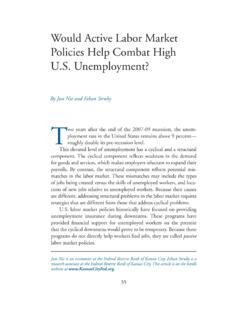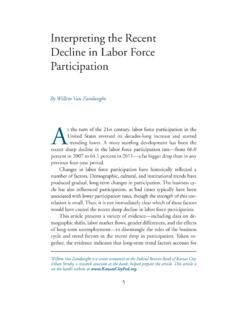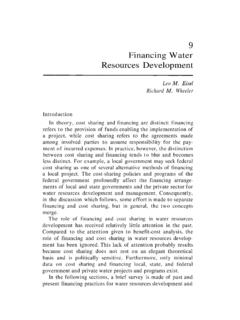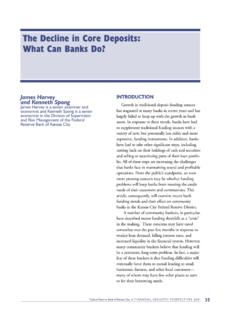Transcription of Predicting Recessions with Leading Indicators: Model ...
1 Predicting Recessions with Leading Indicators: Model Averaging and Selection Over the Business Cycle Travis Berge April 2013; Revised January 2014 RWP 13-05 Original: April 2013 Current: January 2014 Predicting Recessions with Leading Indicators: Model averaging and selection over the business cycle AbstractFour Model selection methods are applied to the problem of Predicting business cycle turning points:equally-weighted forecasts, Bayesian Model averaged forecasts, and two models produced by the machinelearning algorithm boosting. The Model selection algorithms condition on different economic indicators atdifferent forecast horizons. Models produced by BMA and boosting outperform equally-weighted forecasts,even out of sample. Nonlinear models also appear to outperform their linear counterparts.
2 Although theforecast ability of the yield curve endures, additional conditioning variables improves forecast ability. Thefindings highlight several important features of the business cycle. JEL: C4, C5, C25, C53, E32 Keywords: Business cycle turning points; Recessions ; variable selection; boosting; Bayesian modelaveraging; probabilistic BergeFederal Reserve Bank of Kansas CityOne Memorial DriveKansas City, MO 64198 Email: The views herein do not necessarily reflect the views of the Federal Reserve Bank of Kansas City or the FederalReserve IntroductionA common view of the behavior of modern economies is that they oscillate around a trend rateof growth, alternately experiencing phases of expansion and recession. Economic activity growsduring expansions, generally increasing standards of living.
3 These periods of expansion are fol-lowed by sudden and rapid declines in activity, observed across a large number of sectors in theeconomy. Most obviously, economic recession suggests a higher probability of unemployment andlower wage growth, but a growing literature documents many other pernicious impacts of reces-sions, including decreases in lifetime earnings and negative consequences for individuals health andeducational outcomes. For businesses, sluggish growth reduces demand for their wares, decreasingthe availability of profitable economic opportunities and inducing the reduction of these observations, the enthusiasm with which households, businesses and policymakersattempt to infer the current and future states of the economy comes as no surprise. Classifyingeconomic variables into variables that lead, are coincident to, and lag economic downturns is a long-lived tradition in economic research, going back to at least Burns & Mitchell (1946).
4 The yieldcurve is probably the most recognized Leading indicator of business cycle turning points (see, ,Estrella & Mishkin, 1998; Wright, 2006; Kauppi & Saikkonen, 2008; and Rudebusch & Williams,2009), but the financial press reports on a wide-range of economic indicators. There is also anactive academic research agenda focused on producing a statistic that summarizes the state ofthe aggregate economy, as in Stock & Watson (1999) implemented as the CFNAI at the FederalReserve Bank of Chicago Aruoba, Diebold & Scotti (2009), and others. In any event, practitionersfollow a wide range of economic indicators, many of which almost certainly contain additional usefulinformation for the identification of the current or future states of the economy (though many maynot).
5 A primary concern of this paper is the evaluation of the predictive content of a number ofcommonly followed macroeconomic variables. The analysis then focuses on the problem of com-bining disparate signals of recession from many commonly-followed economic indicators. A naturalmethod for combining information from a wide range of sources is to use a factor Model , as in Stock& Watson (1989, 1999), Chauvet (1998), Chauvet & Piger (2008) or Chauvet & Senyuz (2012).However, forecasting Recessions is fundamentally a problem of classification anda priorithere is no1clear reason to believe that the unobserved factor that best captures the cross-sectional variationin a panel of data (for example) will forecast future states of the economy well. Hamilton (2011)argues that while factor models such as the early example of Stock & Watson (1993) are accuratedescriptions of the state of the economy in-sample, their usefulness as forecasting tools may be morelimited if they incorporate misleading indicators, or if the behavior of the incorporated indicatorshas there are many economic indicators that provide useful signals of the present andfuture states of the economy, the relationships between these indicators and the state of the economyis likely not stable over time (Ng & Wright 2013).
6 For example, the slope of the yield curve hasbeen a useful tool for forecasting turning points in the past, but Chauvet & Potter (2002, 2005) findevidence of breaks in the relationship between the yield curve and economic activity. In addition,the financialization of the economy and decline of manufacturing likely altered the predictivecontent of many indicators of the economy. Further complicating matters is the well-documentedasymmetry of many economic indicators around business cycle turning points (Hamilton, 2005;Morley & Piger, 2012).The analysis extends the methodology of forecasting binary time series, focusing on the applica-tion of Model selection over a set of standard macroeconomic variables. The baseline Model relateseach possible covariate to the state of the economy up to 24 months ahead.
7 The analysis comparestwo distinct approaches to performing Model selection, using the best-performing univariate modelfor each forecast horizon as a baseline forecast. The first approach is two applications of forecastcombination. First, suite of univariate models are given equal weights to produce a probabilisticforecast. In addition, a Bayesian Model Averaging approach weights each Model forecast by itsimplied posterior probability. Because BMA averages over all possible combinations of covariates,it allows for a richer forecast Model that conditions on multiple economic second approach is the application of the boosting algorithm. Boosting originated inthe machine learning literature focusing primarily on problems of classification, such as medicaldiagnostics, spam detection, and handwriting identification.
8 Boosting is increasingly applied toempirical problems in method can be specified non-parametrically though the1 See, , Bai & Ng (2009), Khandani, Kim & Lo (2010), Berge (2014). Ng (2014) provides a useful summary ofthe algorithm and also applies the algorithm to the problem of identifying business cycle turning taken here is akin to a logistic regression is highly efficient (and therefore able to handlelarge quantities of data), yet is resistant to analysis investigates the in-sample and out-of-sample forecasting performance of the meth-ods. Many of the indicators included in the analysis contain information that can be exploited tomake forecasts of future states of the economy. Real economic variables most accurately describethe current state of the economy, especially indicators of the labor market.
9 The results also pointto a strong relationship between the bond market and real economic activity, but one that occursonly with a lag. The yield curve is shown yet again to be a robust predictor of future turning pointsendures, with the caveat that its predictive power is limited to forecasts made for the interest rate spreads such as those of corporate bonds also contain information useful forforecasting, especially at very long horizons. Of the methods pursued here, BMA and the boostingalgorithm produce useful probabilistic forecasts of recession. Each of the three methods producedsignals of recession during the most recent 2007-2008 recession at short horizons, although thewarning signals produced ahead of time were less plan for the paper is as follows. The next section describes the methods used for modelcombination and Model selection.
10 Section 3 describes the data and the evaluation of probabilisticforecasts of a discrete outcome. Sections 4 and 5 present the empirical Empirical A baseline modelRecession forecasts are complicated by the fact that the state of the economy is an unobservedvariable. To that end, this paper takes the recession dates of the business cycle dating committeeof the NBER as a gold-standard chronology of the unobserved state of the state of the business cycle as determined by the NBER, whereYt= 1 denotes that monthtisan NBER-defined recession andYt= 0 indicates an expansion instead. The Model assumes thatYt2 See Berge & Jord`a (2011) evaluate the NBER chronology itself, and conclude that thechronology is a useful classification of economic activity, and that the NBER s classification is superior to othercommonly applied rules-of-thumb used to define Recessions .


















